Standards Worldwide
Standards Worldwide
Phone +49 30 58885700-07

Standard [CURRENT]
ASTM D 6530:2019
Standard Test Method for Total Active Biomass in Cooling Tower Waters (Kool Kount Assay; KKA)
- Publication date
- 2019
- Original language
- English
- Pages
- 5
- Publication date
- 2019
- Original language
- English
- Pages
- 5
- DOI
- https://dx.doi.org/10.1520/D6530-19
Product information on this site:
Quick delivery via download or delivery service
Buy securely with a credit card or pay upon receipt of invoice
All transactions are encrypted
Short description
1.1 This test method covers the determination of viable active biomass in cooling tower water in the range from 102 to 108 cfu/mL. It is a semiquantitative test method. 1.2 This test method was used successfully with reagent water, physiologic saline, and cooling tower waters. It is the user's responsibility to ensure the validity of this test method for waters of untested matrices. 1.3 The values stated in SI units are to be regarded as standard. The values given in parentheses after SI units are provided for information only and are not considered standard. 1.4 This standard does not purport to address all of the safety concerns, if any, associated with its use. It is the responsibility of the user of this standard to establish appropriate safety, health, and environmental practices and determine the applicability of regulatory limitations prior to use. For specific hazard statements, see Section 9 . 1.5 This international standard was developed in accordance with internationally recognized principles on standardization established in the Decision on Principles for the Development of International Standards, Guides and Recommendations issued by the World Trade Organization Technical Barriers to Trade (TBT) Committee.
ICS
27.200
DOI
https://dx.doi.org/10.1520/D6530-19
Also available in
Loading recommended items...
Loading recommended items...
Loading recommended items...
Loading recommended items...
